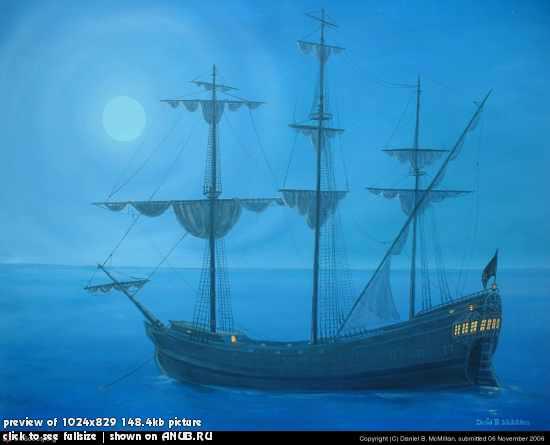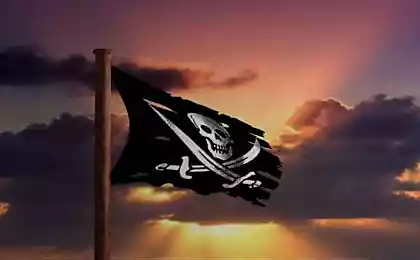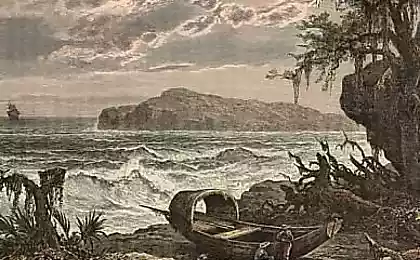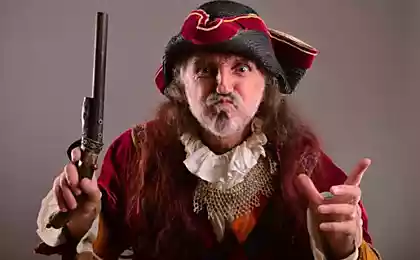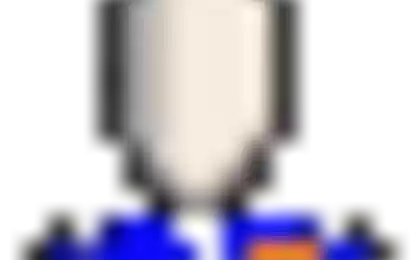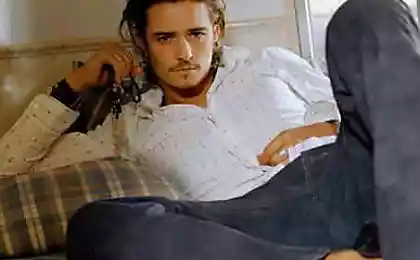2195
Interesting facts about pirates

Today it goes on the computer pirates, namely about the real Caribbean robbers. Enumeration of interesting facts and dispel myths. Text lot!
- Blindfolded - a distinctive feature of many pirates are actually the most common bullshit. No historical evidence that the pirates with damaged eyes closed their bandages still have not found a single one!
However, such dressings have become a characteristic feature of pirates depicted in novels and films of the twentieth century. For example, in "Black Swan" (1942) and "Pirates of the rivers of blood" (1962) notorious villains are such an eye bandage. The illustrations in the novel "Treasure Island" and the movie on the novel by Blind Pew both eyes closed with black armbands.
Pirate treasure
Their loot and treasure zolotishko pirates often hid wherever possible: in the secret caves and grottoes, buried in the ground under the protection of the skeletons. Dozens of books and hundreds of movies where the painting process or burying or burning even more the process of searching and digging these treasures. Thousands naive adventurers scoured the mountain lands in search of pirate gold. Get rich but has not yet been any! And all because of his pirates buried treasure ever!
Yes, it is true, treasure seekers occasionally find treasures in the ship wreck sites, but that was not a pirate hoarded gold, and the Spanish Treasury ships.
Once in the hands of the enemy pirates sometimes tried to buy his freedom with tales of hidden treasures. However, there is still no single evidence that would confirm the truth of these stories. Actually, this is quite understandable.
First, the life of a sailor (and especially the pirate) is so fickle and dangerous, that there is a very high risk of never before pripryatannh denezhek not reach. So why hide them? Is not it better for a walk, is still alive? That is how the pirates, and do, and just about it have a mass of evidence, including Dafoe and Ekskvemelin who write that pirates lowered their shares immediately upon arrival at the port, and if anyone dug and pirate gold, it was the innkeeper.
Secondly, there were more prosaic and serious reasons not to hide. The fact is that any pirate expedition was funded by someone. And those who financed it were not bessrebrenniki. They invested their money in the hope of obtaining large sum and therefore hoarding pirated production would these gentlemen perceived very pessimistic. The matter could well end in murder. Therefore, any pirate had his prey always share with their sponsors.
You can hear the objection that, say, the pirates buried their shares after the division of the loot. Fullness! So can say only those who absolutely can not imagine the financial side of piracy. Pirate captain received only two or three lobes against ordinary sailors who received one share. Even well-known and successful pirate captain could not amass any significant wealth. Isklyuchkeniya were (such as Morgan and Drake), but you have enough fingers of one hand, to list them. And just these captains are not buried his treasures. How Come?
Because burying treasure simply not profitable! Many European banks have their offices in the ports (including the New World) and willingly took the savings under their warranty and good interest rates. Why should bury something that can be excavated by others when you can put money in the bank, where they will be in safe and sound, so even with interest? Moreover, under the legal interest?
That's why none of the pirates no treasure never dug. That does not cancel the artistic and literary value of such works as "Treasure Island».
Bandanas, earrings and other
Most of us at the word "pirate" immediately draws a gloomy imagination thug in raznotsvete dress with a handkerchief, bandana on his head and pierced ears. In fact, the real pirates look quite different.
Usually, all the sailors were about the same clothes, regardless of whether they were on the pirate ships or merchant and military ships. Before the advent of in the XIX century weaving mills clothes were very expensive, and most of the sailors had only one of its kit, which were not taking off until he came into complete disrepair.
In contrast to the rapidly changing fashions in rich layers of society clothing sailors changed slowly. Usually sailors went barefoot. Since the 1500s they began to wear loose, baggy pants, cut between the knee and ankle. This was due to very specific reasons. In more complicated shoes to walk on the slippery deck or climb the ladder, and the short and loose pants let you move faster. Incidentally, the shoes cost while also very expensive.
In good weather, the sailors in the tropics aboard the ship carried only his pants. Go ashore, the officers and men wore knee-length tunic - whole garment resembling a Roman toga or a long shirt, belted at the waist. In the Middle Ages men wore tunics and similar elongated stockings, tight fitting legs.
In the XVI century sailors were very loose pants called "Sloppy» (sloops), which covered the legs just below the knee, stockings and a tunic to the hips, which turned into a shirt when she was tucked in his pants. On board the ship captains went about the same clothes, like most sailors, but to go ashore, dressed more elegantly.
Sir Walter Raleigh, Sir Francis Drake, Thomas Cavendish, Jacques Soret, Francois Le Clerc, and other gentlemen wore costumes appropriate to their position. It was either tights or leggings combination with breeches (pants, tight fitting legs or loose pants with ribbons or garters at the knee). Top wore waistcoats, jackets and coats. Wide frill neck wrapped and almost every captain wore a beard and mustache.
Like other seafarers XVII century, pirates of the Caribbean were loose pants, cropped just below the knee, and in cold windy weather - woolen stockings and a blouse or jacket to the hips. Many were "women's pants." Very wide, they resembled a divided skirt or pants to his knees, who called kyulottami.
In the XVIII century sailors to swim in the cool Atlantic Ocean, preferred to wear baggy trousers to the ankles, linen shirts and blue or gray jacket to the hips (Dutch sailors in cold weather, wear long pants and a jacket).
As a rule, the clothes were made of thick wool, but sometimes sailors sewed their own clothes from damaged sails. bukaniry hunters of animals, often sewed rough shirts, pants and other clothing from the skins of dead animals. Clothing was usually dark in color, it is often impregnated with resin for protection against cold and dampness. Jack Rekhem different from the others, as noted by Daniel Defoe, since only wore white pants and shirts made of cotton.
With only one set of clothes, the pirates on board the ship went dirty and ragged. However, on the shores of some captains shocked the public by dressing as men of noble birth. Leaders Cilician pirates wore tunics and togas as Roman patricians. In 1603 Christopher Oloard insisted that he was hanged in clothes made of velvet and silk. Bartholomew Roberts wore crimson before the battle of Damascus vest and pants, hat with a red feather and diamond cross on a gold chain.
Quite a bit of pirated movies faithfully reproduce clothes depicted era. In the films of the times of Queen Elizabeth I carefully shaved and heroes appear at the court in a rather gloomy clothes. In the films of the Caribbean pirates are not shown in the "women's pants." This is understandable, since historically accurate reproduction of the costumes may be contrary to the basic idea of the film. For example, in the movie "Sea Hawk" Errol Flynn shows a very courageous man, but a real suit, in which he walked in fact, would seem to modern audiences feminine and totally inappropriate. Scoundrels like Blackbeard would look ridiculous, not evil, in the broad "women's pants," though it went Teach in "women's pants."
In some materials Pirates of the Caribbean is sometimes depicted with "Gypsy" earrings (copper or gold rings) in one or both ears. In real life, European men wore earrings (but not the ring!) Only in the XVI century. Even women stopped wearing earrings in later periods when long hair, wigs or hats began to close his ears.
In the 1500s, when it became fashionable short hairstyle, Spanish and English nobles, admitted to the royal court, and sometimes wore earrings. But they were earrings with pearls and precious stones, not metal rings. Sir Walter Raleigh, Sir Francis Drake, the Earl of Cumberland and Sir Anthony Sherley may wear earrings in the court, but left their homes, leaving in flight. In France, earrings briefly in vogue at distinguishes homosexual King Henry III (1551 - 1589).
Earrings longer wear in the 1600s, when aristocrats again began to prefer shoulder-length hair. In England fashion earrings for men, unthinkable when Puritans, not renewed after the restoration of the monarchy in 1660.
The origin of the myth of the earrings of the rings is pretty vague. About earrings do not mention any Ekskvemelin (1678), nor Daniel Defoe in his "General History" (1724 - 1728). Earrings are also absent in the novels of XIX century, such as "The Book of Pirates" (1837), "Treasure Island" (1883) and "Peter Pan" (1904). In the 1890s, Howard Pyle was first mentioned in the text and earrings depicted in the illustrations. However, its pirates sometimes sported silver earrings with gemstones rings instead of Roma. Pyle can be considered the first who portrayed pirate with pierced ears. Pirate with a ring - this is the fruit of the imagination of artists of the twentieth century.
Similarly, earrings, Pyle to be congratulated on the fact that he was the first to wound the head pirate bandana-bandana. No documentary evidence of the sailors and pirates wearing headscarves has not yet been found, it is the fruit of imagination of artists. Pirates also did not wear hats, which obviously would have been thwarted by the first breeze.
Instead, scarves and hats pirates were sitting tight caps, often with ear flaps that are sure to have a rope for tying the bottom.
"Thunder strike me!" - A Russian free translation of the English expression «Shiver my timbers».
For the first time, this expression is found at the end of the 19th century and includes an expression of surprise or disbelief. Its origin is presumably due to the shaking of the ship when striking a submerged rock, is so strong that the whole ship's hull begins to vibrate («shiver»).
For the first time in the literature, this expression is found in Robert Louis Stevenson's novel "Treasure Island" and later it was copied other authors pirate novels and films.
Evidence that this picturesque expression using real pirates are not yet available.
Manowar, varshipy, Battleship
For some time in many computer games were sailing ships, which either never existed or their names are used incorrectly.
1. Manowar
Manowar - this is the English word Man-of-War. In games it is definitely the type of ship, usually naimoschneyshy size, displacement, the team and the number of artillery.
This notion of game creators, this type of ship in real life never existed.
In fact, "Manowar" maritime jargon called simply fighting sailing ships. For the first time the term appeared in the XV century in the Mediterranean. Later, with the advent of battleships, the most powerful of them were also called "Manowar".
Thus, Man-of-War - it's just a nickname.
Those ships are in games called "Manowar" - it's just a three-and chetyrehdechnye battleships 1st class who carried on board 100 or more guns.
The first ship of the line, which earned him the nickname "manovar", was a 104-gun ship of the line chetyrehdechny "Victory", which became the flagship Nelson in the Battle of Trafalgar.
2. Varship
Similarly, "Manowar" games "Varship" - is also the type of ship. And this is also nonsense.
Varship - it's just the English word warship, which translates as "warship" is no more.
In games "varshipom" is usually called the ship, which in real life can be attributed to second-class battleship.
3. Battleship and battleship.
In fact, one and the same type of vehicle. Just in English, there are two terms that denote the same ship: battleship and ship-of-the-line. Both the word translated as "battleship, battleship." Name of the ship came from the main tactics of its combat system: fight in line. Therefore, first coined the term «ship-of-the-line». Much later, in the 20th century, after outlived its time not only sailing ships, but also armored dreadnought battleships and reappeared, they became known as battleship. In modern English, mainly used this word, but when it comes to the battleship sailing fleet, it still uses the term ship-of-the-line.
The result is that "manovar" and "varship" and "Battleship" and "battleship" - in fact the name of the same type of ship: battleship first or second class.
